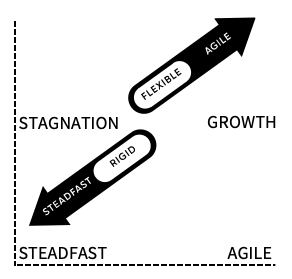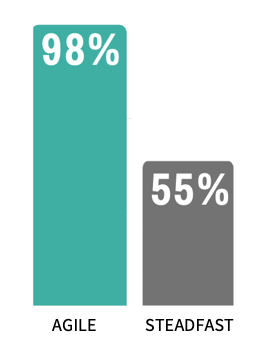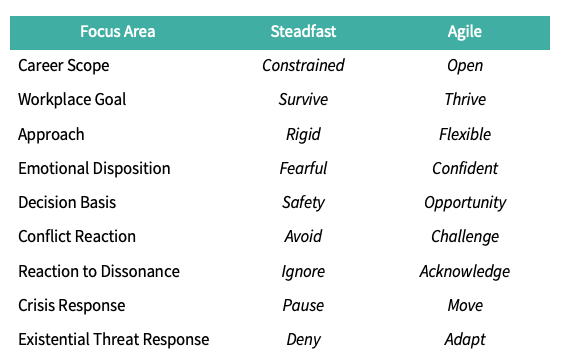
Live at the edge of your abilities or risk being abandoned in stagnation nation.

This might sound extreme, but it describes two opposite ends of a scale on your career path shown in the diagram. Most of us fall somewhere in between. For those who are steadfast, it is increasingly difficult to stay the course when the variables of change multiply.
So here’s the problem. Organizations and people fail when they stagnate. When they fail to respond to change.
This post highlights my original research findings and insights from the Career Agility Research Project that will be featured in a longer white paper.
Agility Solves Stagnation Problem for Individuals and Organizations
Let’s review an example of how one woman flexed her agility muscle in favor of adapting to technology change.

In 1995, Colleen Cannon-Ruffo, a high school Spanish teacher with a quick smile and hearty laugh, made a decision. She decided to get a master’s degree in instructional technology. When the world’s first internet boom shattered the conventional workplace, Colleen assessed technology was about to transform the education profession.
Over the next twenty years, she embraced new technology at every turn migrating from Spanish teacher to instructional technologist. Her creative navigation included:
- She qualified as one of the first instructors in a train the trainers program for instructors at Argonne National Laboratory. During the summers, she coached educators on technology integration in their classrooms.
- For several years, she juggled classroom responsibilities with after-hours educator tech training. Her patience paid off when her district invited her to apply for a newly created role in instructional technology.
- Lego reached out to her to help them to deliver workshops on how robotics are used within the Lego offering.
- She works as an Apple Foundations Trainer as one of her side gigs.
- She is now completing her PhD in Instructional Technology,
So, what is the point of this story?
Career agility is the best antidote for individual and organizational stagnation. This approach is a necessary response to the continual waves of personal, technology, and corporate change.
Now let’s take a look at what is happening on the organizational landscape and highlight some examples of indecision. Getting stuck is not reserved for the individual, rather there are numerous examples of stagnation risk.
Organizational Stagnation and Future Predictions
The shrinking corporate lifecycle is not exactly headline news. Over the last decade, business visionaries and social commentators have predicted the demise of the legacy corporate landscape.
They foretell the extinction of well-established companies occurring in fewer than ten years, supported by historical proof points:
- The life expectancy of a Fortune 500 company has dropped from seventy-five years (fifty years earlier) to fewer than fifteen years.
Stephen Denning – 2011 - More than one-third of businesses will not survive the next decade, failing in particular in their efforts to go digital.
John Chambers, CEO Cisco Systems – 2015 - In 1964, companies on the S&P 500 enjoyed average listing tenures of 33 years. That average narrowed to 24 years by 2016 and is forecast to shrink to just 12 years by 2027.
Innosight Strategy and Innovation Longevity Forecast – 2018 - The next ten years will see more change than the last 100
Yuval Noah Harari, Homo Deus – 2018
Organizations who Fail to Adapt Have Shortened Lifespans
The list of companies that have already succumbed to destructive change is long and sobering, full of brands that once defined the modern economy:
- Kodak invented the digital camera, as a prototype, but failed to predict the utter dominance of digital photography embodied in the smart phone.
- Borders catered to an emergent Gen-X/Gen-Y café culture, but fell beneath the onslaught of Amazon and other online booksellers and retailers.
- Lehman Brothers, Motorola, Sears, Radio Shack, Blockbuster, Yahoo, and Blackberry survive as mere shadows of their former selves.
Even startups, the “new kids on the block”, companies who disrupt the existing marketplace are not themselves immune to disruption, especially if they slip into the roles and habits of the players they displace.
The lifespans of new companies, no matter how nimble they appear, are similarly predicted to shorten, to be even briefer than their predecessors.
To meet this wave of change, organizations will require agility in their workforce, leadership and practices. Organizations, leadership, and staff need to adapt to the pace of change.
Agility Research Findings
The career agility research revealed a number of differentiators that helped determine whether an individual behaves more Steadfast vs. Agile in the course of their career:
- How they respond to change
- How they seek help to grow, and in meeting job and career challenges
- How they prioritize career choices
Response to change is perhaps the most critical factor in defining agility. While 70% of professionals overall highlighted adapting to change as important, 98% of agile thinkers prioritized adapting to change as opposed to 55% of steadfast careerists.

70% of professionals thought it important to adapt to change: 98% of agile thinkers prioritized adapting to change vs. 55% of steadfast careerists
Career Agility Research Report: Marti Konstant
So, how do attitudes between steadfast vs. agile careerists differ in response to change? Analysis of the survey data highlighted a series of key differences in how respondents thought about work and career, illustrated in the following table.
The Attitudes of Steadfast and Agile Careerists
The steadfast column reflects a rather dire outlook. Most workers and managers would not openly admit to so bleak a professional worldview. However, these stark contrasts were borne out by data in our study.

Anecdotal feedback during presentations on this topic indicate many workers aspire to adopt an agile mindset. When posing the question during presentations, “do you have an agile mindset?,” over 70% view themselves as north of the halfway point on the agility scale.
Access the agility behavior infographic here.
While I don’t believe this informal live poll reflects reality, it likely reflects an aspirational perspective. The real poll indicates closer to 40%.
Good news is there is an understanding that agility thinking can tackle stagnation.
Summary: Individual Career Agility Enhances the Agile Organization
Today’s workplace exists in a state of revolution and constant reinvention. This ongoing transformation demands a new outlook for employers and workers alike. Corporate leadership, middle management, indeed all types of contributors must learn to adapt to this current of change or find themselves unemployed and unemployable.
To meet this wave of change, organizations will require agility in their workforce, leadership and practices. Organizations, leadership, and staff need to adapt to the pace of change.
For those interested in a deeper dive on this topic, the extensive white paper will publish in Fall 2019.
Target Audience:
- HR professionals, hiring managers, and executives concerned about organizational culture and success
- Individual workers who want to solidify their position and expand their value in the future of work.
Related posts:
New Career Agility Research: 3 Behaviors Shaping Future Workplace
Stagnation is the Enemy of Employee Retention
Workplace Agility for Careers and Companies
If you are interested in the future of work, career development, the workplace, personal branding, workforce trends/ideas, agility, or how to cultivate happy profitable employees, subscribe to Marti’s 52 Ideas. For more details on career agility, check it out here.
You can also check out the best-selling book on Amazon, Activate Your Agile Career: How Responding to Change Will Inspire Your Life’s Work.
